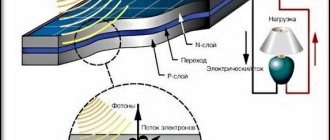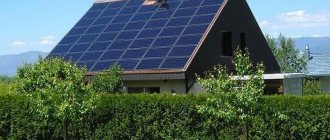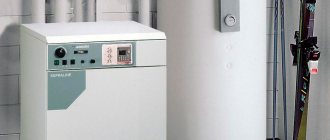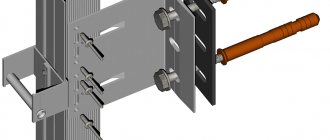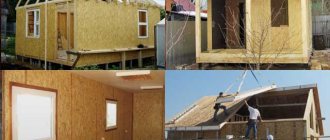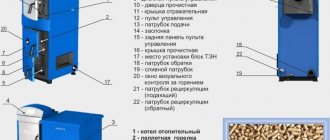Main characteristics of solar panels for home
When starting to consider the topic of solar panels, you first need to pay attention to the photovoltaic power supply system. This device converts sunlight into electrical energy. For two hundred years now, humanity has been improving this equipment, and successfully. That is why every day more and more people are interested in installing a solar panel.
But which one should you choose https://e-solarpower.ru? There are three types of systems depending on the specifics of the alternative energy source.
The first type is characterized by open photovoltaic power supply systems (PSS). They do not have batteries, and the equipment itself is powered through a special inverter. The main network will not work if the power generated is greater than the power consumed.
In the reverse situation, the solar panel kit for the home stops functioning and power is maintained through the main grid. The systems described are quite reliable and cheaper than others, but if there is no power from the main network, the system does not work.
The second type is characterized by autonomous systems independent of the main network. FSEs of this kind operate in their network outline to directly power all equipment. The best performance is observed in the presence of a battery, which uses the accumulated energy when the solar energy supply deteriorates, and also if the generated power is greater than the consumed power.
The third types include the combination of the two previous categories. Combined FSEs have great functionality. It is even possible to transfer unconsumed generated energy to the main grid. But this type of system is the most expensive.
Types of batteries
Virtually any battery can be used for solar panels. But the main thing is that it works for a long time. The functioning of the battery depends on the type of manufacture and materials.
Main types of energy storage devices:
- Lithium.
- Lead-acid.
- Alkaline.
- Gel.
- AGM
- Filled nickel-cadmium.
- OPZS.
Lithium
Energy appears in them at the moment when lithium ions react with metal molecules. Metals are additional components.
These types of batteries are capable of charging very quickly with a large capacity. These batteries weigh little and have a compact size. In addition, their cost is quite high. Because of this, they are almost never used in solar energy. They work 2 times less than gel ones. But it will last even less if the charge exceeds 45%. It is at this point that they are able to keep the volume of the container at the desired level.
Such batteries operate in small voltage ranges. A significant disadvantage of such devices is that the capacity decreases over time. And this does not depend on compliance with all technical rules.
Lead-acid
At the development stage, they were equipped with several compartments for electrolyte with a water solution. Lead electrodes and various impurities are immersed in this mixture. Thanks to this, the battery is resistant to corrosion.
Such devices do not work for long. This is explained by the speed of discharge.
Alkaline
These batteries have little electrolyte. Their chemicals are not able to dissolve in it. They don't even react to each other.
Alkaline (alkaline) batteries can last quite a long time. They are well resistant to power surges. Unlike gel batteries, these batteries are able to operate stably at low temperatures. Moreover, in the cold they are able to work for a long time.
They must be stored 100% discharged. This is necessary in order not to lose capacity during future charging. This feature can seriously disrupt the functioning of a solar power plant.
Gel
This type has this name because the electrolyte in it is presented in the form of a gel. Due to the lattice layer, it practically does not flow.
This solar battery lasts a long time and can be recharged many times. Resistant to mechanical damage. Various types of cracks will not disrupt its functioning.
It can operate at low temperatures down to -50 degrees and its capacity does not decrease. After a long period of inactivity, the gel battery does not lose its properties.
If you are going to use this battery in a cold room, then it should be insulated. Under no circumstances should the charge level be exceeded. Otherwise, it may explode or malfunction. In addition, they are highly sensitive to voltage surges.
AGM
In fact, they belong to the lead-acid type. But there is a difference - it is the fiberglass inside that is in the electrolyte. Acid fills the layers of this material. This makes it possible for it not to spread. All this suggests that such a solar battery can be placed in any position.
Such batteries have a good amount of capacity, last a long time and can be recharged up to 500 or 1000 times. It all depends on the manufacturer. But despite all the advantages, there is a significant drawback. They are sensitive to increased current. This may cause the casing to swell.
Cast nickel-cadmium batteries
They are alkaline and require electrolyte filling. Unlike jelly-filled batteries, they are safer. Their cost is not high and the power is maintained quite well. Able to withstand many charge and discharge cycles.
The service life is quite short. The longer you use it, the smaller its capacity becomes.
Car batteries
These devices are quite beneficial in terms of saving money. People who make their own solar power plant most often use them.
The disadvantage of these batteries is rapid wear and frequent replacement. As a result, they can be used for a short period of time and for low power solar modules.
Cost of solar panels
The cost of the main element of a solar panel system varies from 50 to 60 rubles per 1W of power. That is, the cost of solar panels for a house with a power of 200-300 W will be 12,000 and 18,000 rubles. To answer the question: How many solar panels do you need for a home? – it all depends on the amount of energy you consume.
The cost of a system element depends on the power indicators and components. Statistics show that the price-to-electricity ratio is 8.8. Which highlights the advantage of solar electricity over the main grid.
To calculate solar panels for a home, nothing supernatural is required. You just need to calculate the consumption of all electrical appliances per day, and then multiply the resulting number by the number of days in the month.
When calculating the power of solar panels, it is important to consider the amount of energy you consume. For example, if this number accounts for 300 kWh monthly, then exactly this amount of energy generated by solar panels will be required.
It is extremely important to pay attention to fire safety when choosing an electrical supply system, since not only the health, but also the life of both yourself and your loved ones may depend on it.
Set of equipment for a solar station
A powerful solar battery for a summer residence is not a self-sufficient device. The resulting energy needs to be stored somewhere in order to fully use household electrical appliances in the evening and in cloudy weather.
Therefore, we will need a capacious and durable battery in any case. There is one important nuance in his choice: do not try to save money by buying a starter car battery. It is poorly suited for cyclic energy storage and does not tolerate deep discharge. Its main purpose is to provide a powerful but short-term current to start the engine.
To store and slowly consume energy, you need a different type of battery: AGM or gel. The former are cheaper, but have a short service life (up to 5 years). Gel batteries are more expensive, but they last much longer (8-10 years).
The controller is another important element of an autonomous solar station. It performs several tasks:
- Disconnects the battery from the battery at the moment of full charge and turns it on for a new pumping of electricity.
- Selects the optimal charging mode, increasing the amount of stored energy.
- Ensures maximum battery life.
There are several types of controllers used in solar stations:
- ON/OFF “turned on and off”;
- PWM
- MPPT.
The cheapest device simply disconnects the solar panel from the battery when the voltage at its terminals increases to the maximum level. This is not the best option because at this point the battery is not yet fully charged.
A more expensive PWM controller acts “smarter”. After reaching the maximum voltage, he lowers it to the specified level and holds it for another couple of hours. This achieves a more complete level of energy accumulation.
And finally, the most intelligent MPPT-type controller uses the power of the solar panel as efficiently as possible in all modes of its operation. This allows you to store an additional 10 to 30% of electricity in the battery.
Regardless of the type of semiconductor materials used (polycrystals, single crystal, amorphous silicon), the solar battery device is a chain of series-connected module cells. Each of them generates a small voltage (within 0.5 volts) and a weak current (tenths of an ampere). Working together, they “drain” the accumulated energy into a common channel and at the output of the battery we receive a high current and constant voltage (12 or 24 Volts).
Block diagram of solar station equipment
Standard household electrical appliances are designed for 220 Volts, so they will not operate on constant power. The conversion of direct current to alternating current is performed by a separate inverter device. It completes the chain of equipment required for a solar battery.
Despite the relatively high starting cost of the components of a solar station, its operation is profitable due to the long “life” resource of the main elements: the photocrystalline panel and the battery.
How to connect solar panels to the grid at home
There should not be any extreme difficulties in connecting solar panels to the home network. You just need to pay attention to the polarity when connecting the plugs to the correct connectors.
But if you need solar electricity together with a fixed network, then you should use the following solar panel connection diagram:
As you may have noticed, the main thing is to carefully distribute the load at the output. Under no circumstances should you form a direct connection between the inverter and the controller, as this will lead to a complete lack of electricity in your home!
How to connect plates
To connect the plates correctly, you need to know some principles:
- To increase the voltage at home, when soldering plates, you need to know that to increase the voltage they must be connected in series, and to increase the current - in parallel.
- The gap between the silicon wafers should be 5mm on each side. This is necessary because the plates can expand when heated.
- Each converter has two tracks: on one side they will have a “plus”, on the other – a “minus”. Connecting all parts in series into a single circuit.
- Conductors from the last components of the circuit must be brought out to a common bus.
Important: to avoid self-discharge of the device at night or in cloudy weather, you can install a Schottky diode 31DQ03 or another analogue on the contact from the “middle” point.
When all soldering work is completed, you can check the output voltage using a multimeter. It should be 18–19V to provide a small house with electricity.
Solar panels in the future
There is no specific exact position among buyers regarding open photovoltaic power supply systems yet. A significant condition when purchasing FSE is the ratio of price and quality. There are pros and cons to solar panels. The quality of even the same products can be completely different between different sellers.
It will take some time for a more accurate opinion to emerge among clients. However, new technologies immediately appear in our lives. The market for the products offered is large. You should choose the most responsible seller who will provide advice on design and will undertake proper installation with a guarantee.
Before purchasing, be sure to pay attention to the price and reviews from other buyers. No one is immune from deception. But if you approach the acquisition of new technology for your home wisely, the result will not be long in coming. And first of all, it will affect the savings of your financial budget.
